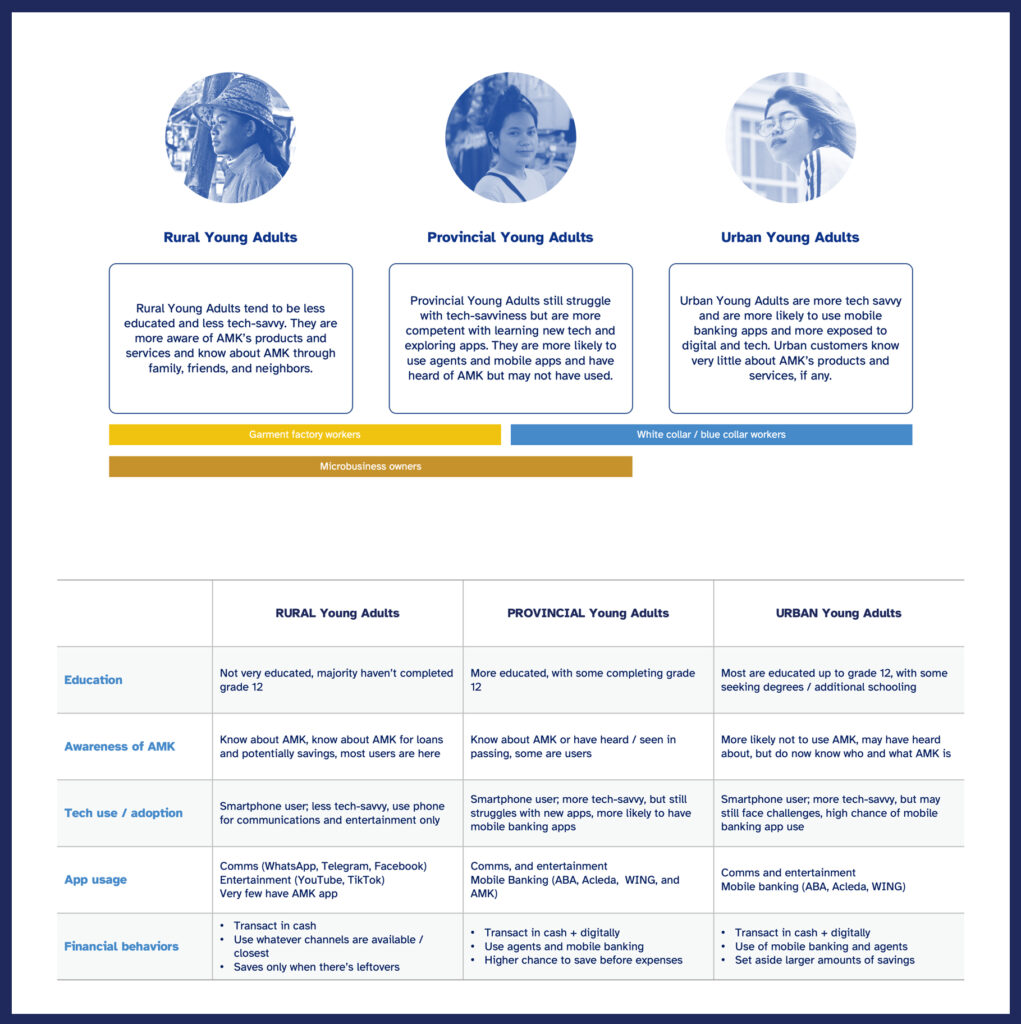By Ker Thao, Maria Serenade, and Elwyn Panggabean
In Cambodia, three million out of 10 million young adults remain financially underserved, hindering their ability to plan and invest for their futures.
As part of its drive for greater financial inclusion, Women’s World Banking is working with AMK Microfinance Institution – one of the leading microfinance institutions in the country – to design, test and deliver solutions for this demographic.
This is the first of a two-part blog summarizing Women’s World Banking’s advisory work with AMK.
Cambodian Young Adults: Low Financial and Digital Literacy Levels but Eager to Save
Just a year ago, Kea Borann, AMK’s Chief Executive Officer and a vocal proponent of serving low-income Cambodians, drew attention to two facts: AMK’s most extensive customer base is over 40 years in age and this segment has working-age children.
Next, he posed the question, “To serve the low-income young adult segment of 15- to 35-year-old Cambodians, what do we need to do to understand them better?”
The United Nations identifies youth as a population between the age of 15 and 24, although it also acknowledges that this may vary from country to country. AMK seeks to introduce its digital financial services to young adults aged 15 to 35, representing about 65% of the Cambodian population, with exposure to technology and smartphones. Understanding and reaching this population is key to how AMK can successfully strategize its digital financial services offering to this group.
In May 2022, Women’s World Banking conducted customer research by interviewing 45 low-income young women, including students and women who work in factories, tourism, and informal sectors, often at their homes after work. Their locations included rural, provincial (outside city centers), and urban areas.
Our research revealed three unique personas among low-income young adult women in Cambodia. These women share some similarities regarding smartphone ownership and awareness of financial services. However, there are unique differences across the three segments in their preferences, capacities, and behaviors towards digital financial services.

Need for More Literacy and Accessible, Trustworthy Digital Financial Services
All the women we interviewed own and use smartphones daily for communication, entertainment, and business, but only a small number are aware of mobile banking. This reality reflects survey findings from The Mobile Gender Gap Report by the GSMA in 2023. The report found that women in low-middle-income countries, including Cambodia, are less likely than men to use mobile internet and mobile money due to low literacy. Among these women, knowledge and use of digital financial services and products – including where to sign up for an account – remain low. Our analysis suggests that these customers need to gain more awareness and understanding of the features and benefits of using digital financial services and where to begin and sign up for an account.
Most interviewees emphasized the importance of trusted, safe, and accessible places to save money. They see the benefits of digital services as convenience, time efficiency and ease of transaction tracking.
There are still reservations due to fears and misconceptions of digital scams, especially among less tech-savvy customers, and fears of losing their accounts and money if their phones are lost or stolen. These concerns arise mainly due to limited experience and use of digital financial services and low digital literacy levels. However, with proper digital financial capability strategy and training, these women customers would be willing to use digital financial products and services.
Savings Is Critical
Although saving is a challenge, the women still put aside small amounts for school fees, monthly expenses, and a future business, among others.
For example, an entrepreneur from Pursat Province sells maternal and baby supplies, earning $200 monthly. She uses a piggy bank and an AMK account to build funding to expand her business, demonstrating how customers use different savings methods.
Our Solution: Using Savings As An Entry Point
Leveraging insights from the customer research, we worked with AMK to develop a solution and strategy to reach young adult women and to introduce and position AMK as a lifelong financial service provider they can trust for their financial needs, starting from their university. The primary strategy of the solution leverages short-term savings into the AMK mobile account to help build customers’ trust in using digital financial services and encourage them to transact digitally using AMK’s mobile banking application.
There are three principles and ways to achieve them:
- Raising customers’ digital financial capabilities
Strategy: Awareness Campaign
Online and in-person campaigns are crucial to educating customers about financial management and digital financial services. This can also be an opportunity to introduce AMK products and values to instill trust. - Accessible service touchpoints
Strategy: Account Sign-Ups and Learn-by-Doing Visual Tutorials
Support and service accessibility is paramount when women decide on a financial services provider. Therefore, ongoing customer support is vital, starting from the account sign-up. In addition, video tutorials should be available through AMK mobile banking apps and YouTube to guide customers on digital activities such as phone top-ups, transfers, the opening of savings accounts, and other financial transactions. In the long run, it is also essential for the provider to build more channels/touchpoints and interoperability with different platforms to ease customer transactions. - Cost-effectiveness and more transactions
Strategy: Incentivize and Promote Transactions
Customers are attracted by products and services that bring additional benefits. Such value should be communicated clearly and regularly through real-life cases. Providing incentives to drive transactions via AMK’s mobile banking application is integral to our solution.
Next Steps: Measuring Our Impact
In the next part of the blog, we will share results and learning from the pilot implementation.



